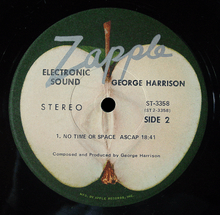Electronic Sound
| Electronic Sound | ||||
|---|---|---|---|---|
.jpg) | ||||
| Studio album by George Harrison | ||||
| Released |
9 May 1969 (UK) 26 May 1969 (US) | |||
| Recorded |
November 1968, February 1969 Sound Recorders Studio, Los Angeles; Kinfauns (Harrison's home), Surrey | |||
| Genre | ||||
| Length | 43:50 | |||
| Label | Zapple | |||
| Producer | George Harrison | |||
| George Harrison chronology | ||||
| ||||
Electronic Sound is the second studio album by George Harrison. Originally released in 1969, it was the second and final record released on the Beatles' short-lived Zapple Records label, a subsidiary of Apple Records. The album comprises two lengthy pieces performed on the Moog synthesizer. Harrison subsequently introduced the instrument to the Beatles' sound; the band featured synthesizer for the first time on their 1969 album Abbey Road.
The first digital edition of Electronic Sound appeared on CD in 1996. Digital editions use a different track order from some of the original vinyl LP copies.
History
Zapple was intended as a creative outlet for avant-garde musical works. Not long after the release of this album, the label was folded at the insistence of the Beatles' then-manager Allen Klein. Because of its experimental and highly non-commercial nature, Electronic Sound failed to chart in the United Kingdom, and barely made the United States Billboard 200 album chart, peaking at number 191.
Synthesist Bernie Krause later pursued legal action against Harrison, claiming that "No Time Or Space" (UK LP side two, US LP side one) was essentially a recording of him demonstrating the Moog III to Harrison (this is detailed in Krause's book Into a Wild Sanctuary). Krause also claimed that the demonstration was recorded and released without his knowledge or consent. Krause's name was originally credited on the front cover under Harrison's cover credit, but it was painted over at Krause's insistence.[1] Despite this, the words "Assisted by Bernie Krause" can still be read from under the silver ink on original LP pressings.
The music was performed on a Moog IIIc modular system which Harrison bought directly from Robert Moog. The synthesizer is still owned by the Harrison family and is pictured in the centre photo spread on the 2014 CD reissue.

Release
| Professional ratings | |
|---|---|
| Review scores | |
| Source | Rating |
| AllMusic | |
| MusicHound | 1/5[3] |
| Rolling Stone | (mixed)[4] |
| The Rolling Stone Album Guide | |
| Uncut | |
The album was released on Zapple Records in the UK on 9 May 1969.[7] On some vinyl versions, such as the original US and Canadian pressings, the order of the recordings was accidentally switched, though the titles were not. This mistake has caused many listeners to confuse the two titles. When the album was issued on CD for the first time in late 1996, the correct UK running order was used. Other editions, such as the 2014 digital download version use the same CD running order.
LP side one "Under the Mersey Wall" (18 minutes) uses the sound of two Moog instruments playing at the same time, an effect made possible through the use of overdubbing. At the beginning of this recording different instruments can be heard from the left and right stereo speakers.
LP side two "No Time or Space" (25 minutes) begins with a series of firecracker-like sounds and appears to be a performance of a single Moog instrument, though it often makes use of tape delay and echo effects. Portions of white noise from this track are used throughout "I Remember Jeep", one of several jams included on Harrison's third solo album, All Things Must Pass, released in 1970.
The cover of Electronic Sound was painted by Harrison himself. The inside sleeve included minimal notes on the album and a quotation attributed to Arthur Wax: "There are a lot of people around, making a lot of noise; here's some more." The words "Produced by George Harrison" appear on front cover of the original LP pressings printed in light blue ink, but were recolored in dark blue and red on later re-issues.
The album was reissued in remastered CD form on 22 September 2014, as part of the Apple Years 1968–75 Harrison box set.[8] The album was also released as a high resolution 24 bit 96 kHz digital download at the same time.
In its 2004 album guide, Rolling Stone rated the release 2½ stars (out of five) and called the album and its predecessor, Wonderwall Music, "interesting, though only for established fans".[5] Writing for MusicHound, Roger Catlin suggested that Electronic Sound "may interest students of early synthesizer experiments, but nobody else".[3]
Track listing
All pieces credited to George Harrison.
- Side one
- "Under the Mersey Wall" – 18:41
- Side two
- "No Time or Space" – 25:10
- Recorded in California in November 1968 with the assistance of Bernie Krause[8]
Note: This is how the titles appear on UK LP versions, CD editions and digital downloads. US and Canadian LP pressings incorrectly switched the order of the recordings but did not switch the titles.
References
- ↑ http://astronautapinguim.blogspot.co.uk/2012/12/five-questions-to-bernie-krause.html
- ↑ Electronic Sound at AllMusic
- 1 2 Gary Graff & Daniel Durchholz (eds), MusicHound Rock: The Essential Album Guide, Visible Ink Press (Farmington Hills, MI, 1999; ISBN 1-57859-061-2), p. 529.
- ↑ Ward, Edmund O. (9 August 1969). "Records". Rolling Stone. Retrieved 1 October 2015.
- 1 2 "George Harrison: Album Guide", rollingstone.com (archived version retrieved 5 August 2014).
- ↑ Nigel Williamson, "All Things Must Pass: George Harrison's post-Beatles solo albums", Uncut, February 2002, p. 60.
- ↑ http://www.jpgr.co.uk/zapple02.html
- 1 2 3 "Electronic Sound (2014 Remastered)". George Harrison. Retrieved 4 September 2014.